Vietnamese Students Learning the Semantics of English Prepositions
Prepositions are significant in sentences because they are used as markers to join words and
phrases into a sentence. Teachers usually teach prepositions by providing students with
explanations about the usage of prepositions and then gives examples as illustrations. These
examples are often accompanied by vivid pictures. This method, however, does not provide
students information on how to analyze the different senses of prepositions. This current
study, thus, aims to explore the effectiveness and students’ opinions of new pedagogical
instructions on ten English prepositions, namely above, among, at, behind, beside, between,
in, in front of, on and under. The research design involved a quasi-experimental design
adopting pretest-posttest between-group research. Out of 95 students who volunteered to
participate in the study, 38 participants were selected. They were divided into two groups for
the new cognitive linguistic approach and traditional instructions. Pretest and posttest were
used to discover the participants’ improvements. The participants’ opinions of the cognitive
treatment were also investigated. The findings illustrate that the group that was treated with
CL-based instructions outperformed the traditional group in the posttest although they gained
a comparable mean score in the pretest. Most participants also provided positive responses to
the new treatment. The findings suggests that cognitive treatment could be employed to assist
students in improving their understanding and retaining the metaphorical meanings of the
prepositions.
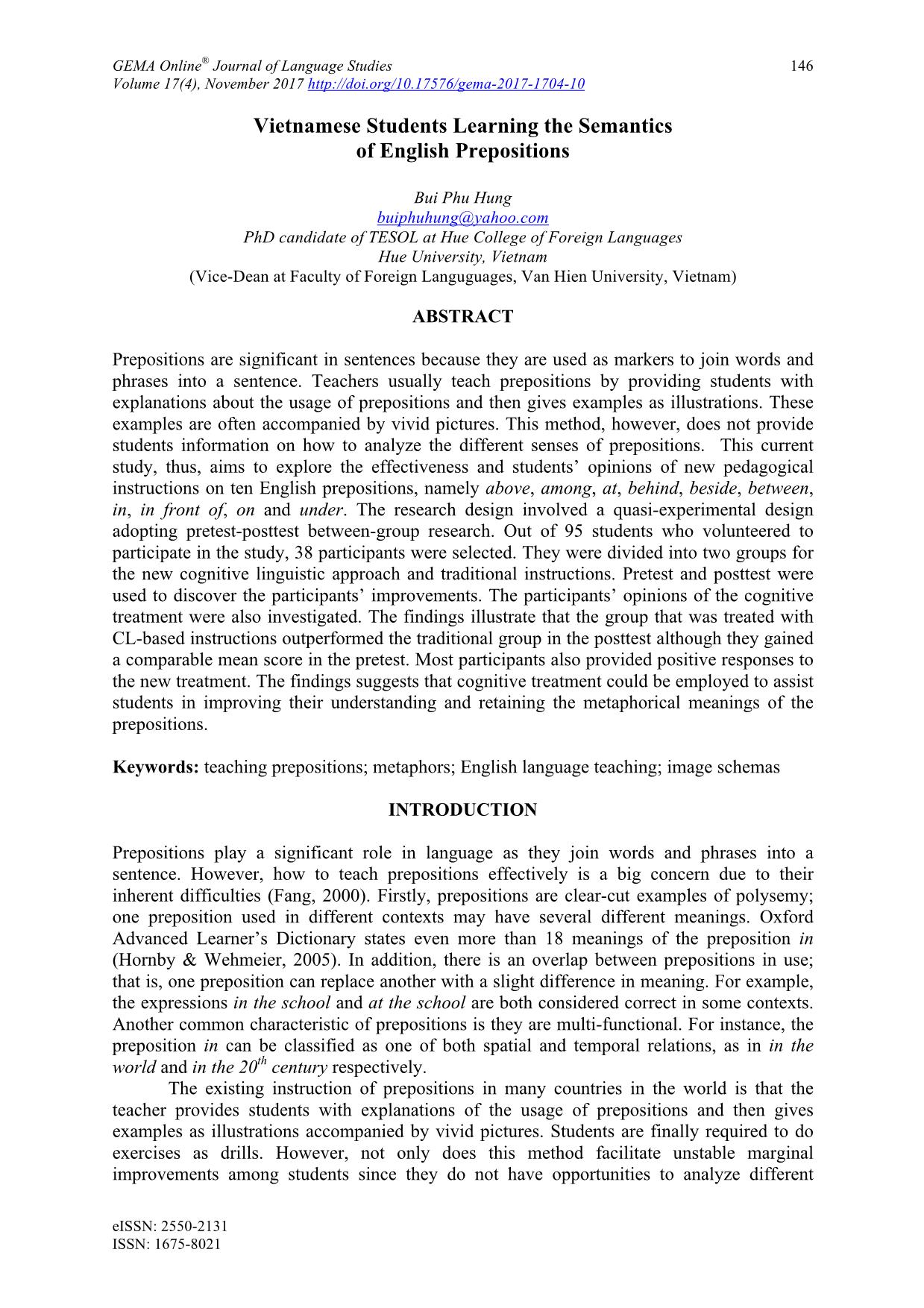
Trang 1
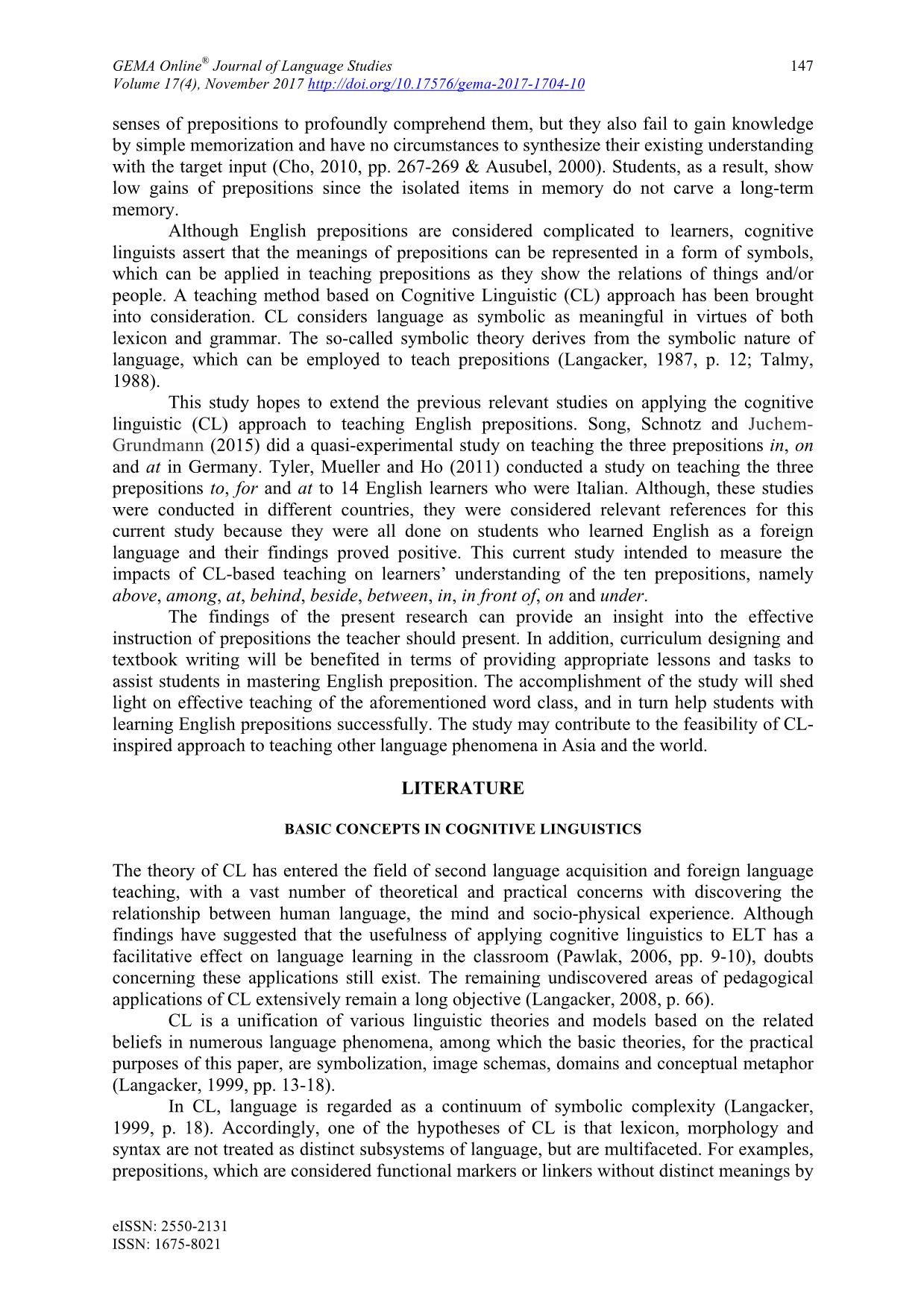
Trang 2
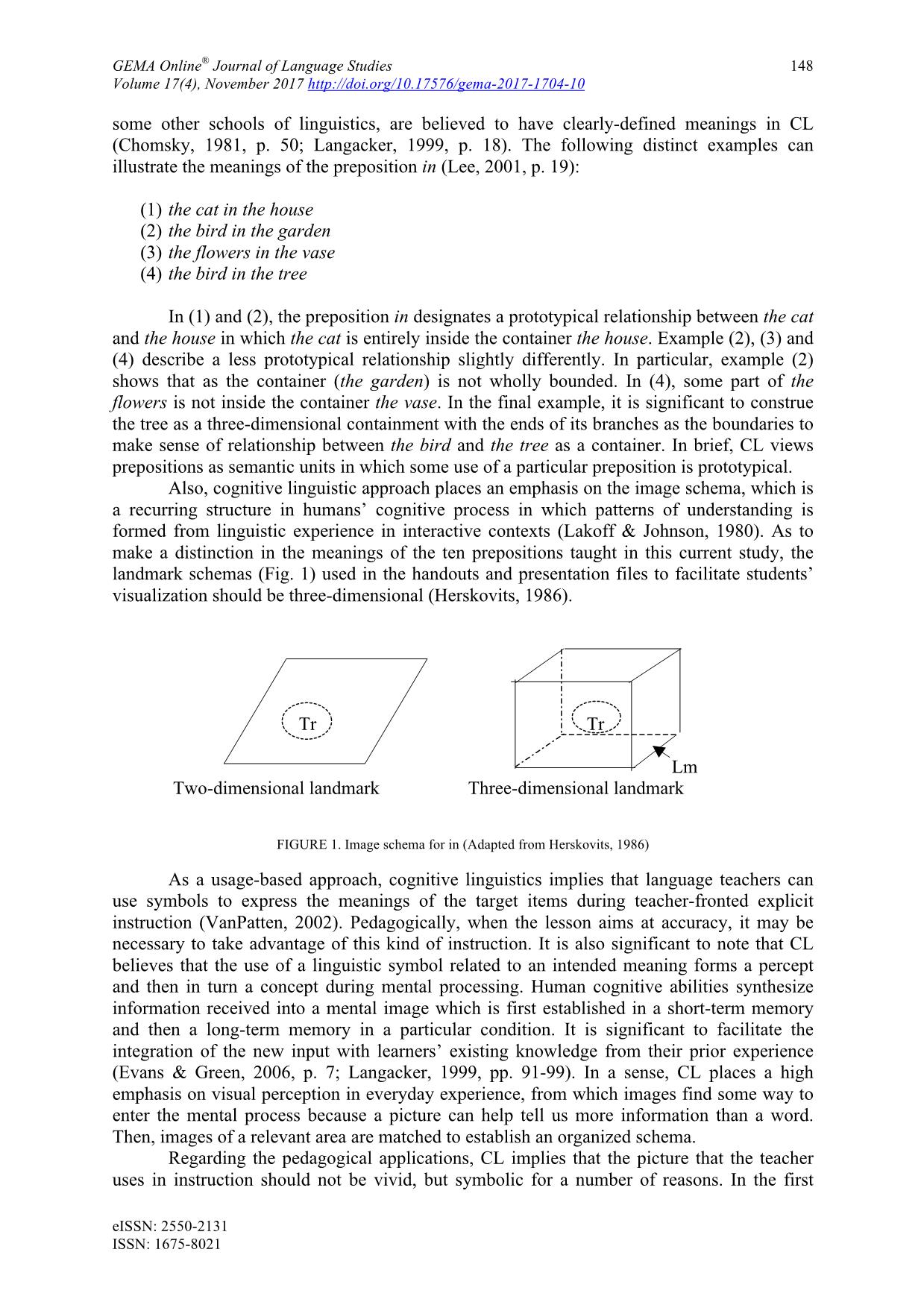
Trang 3
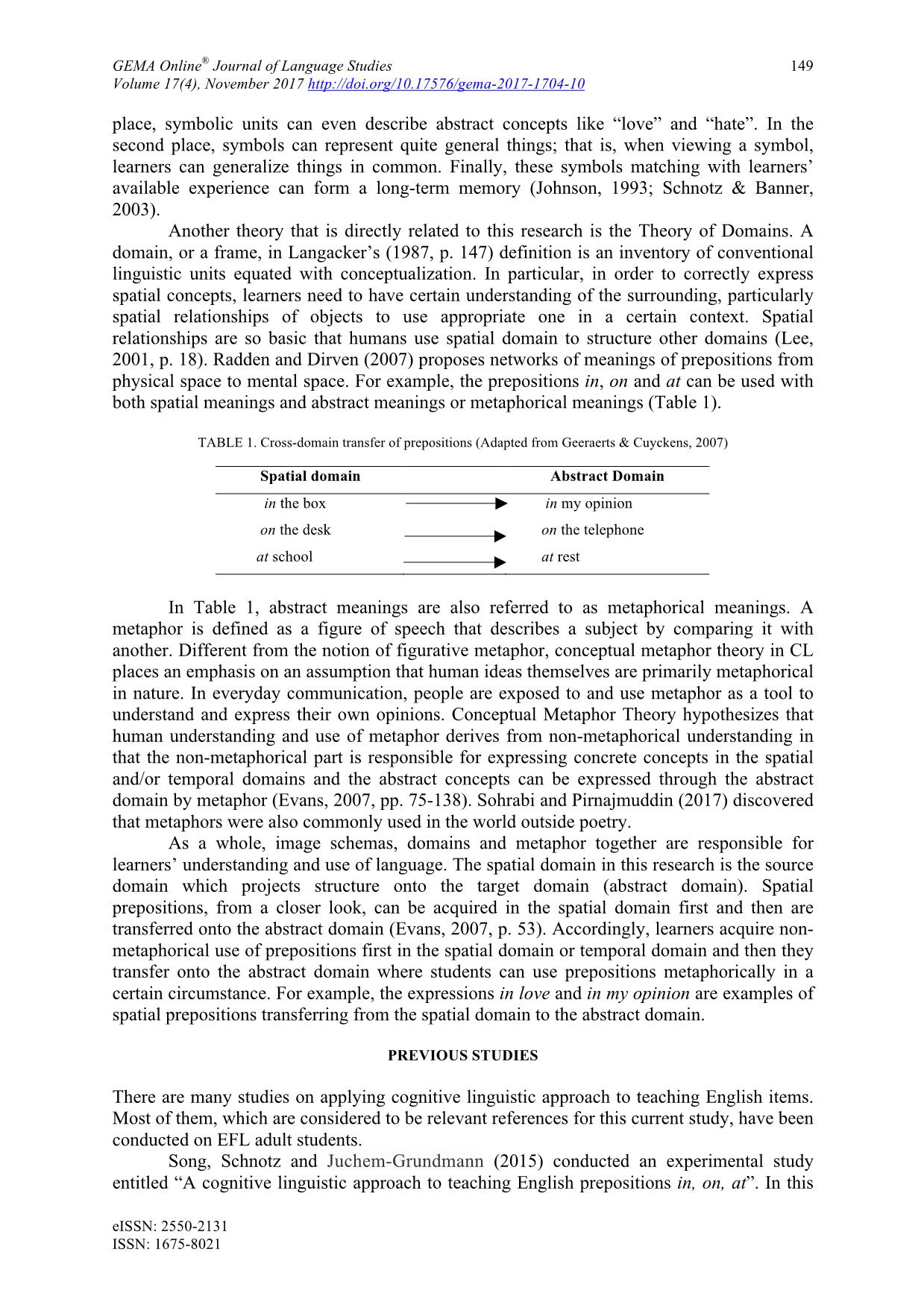
Trang 4
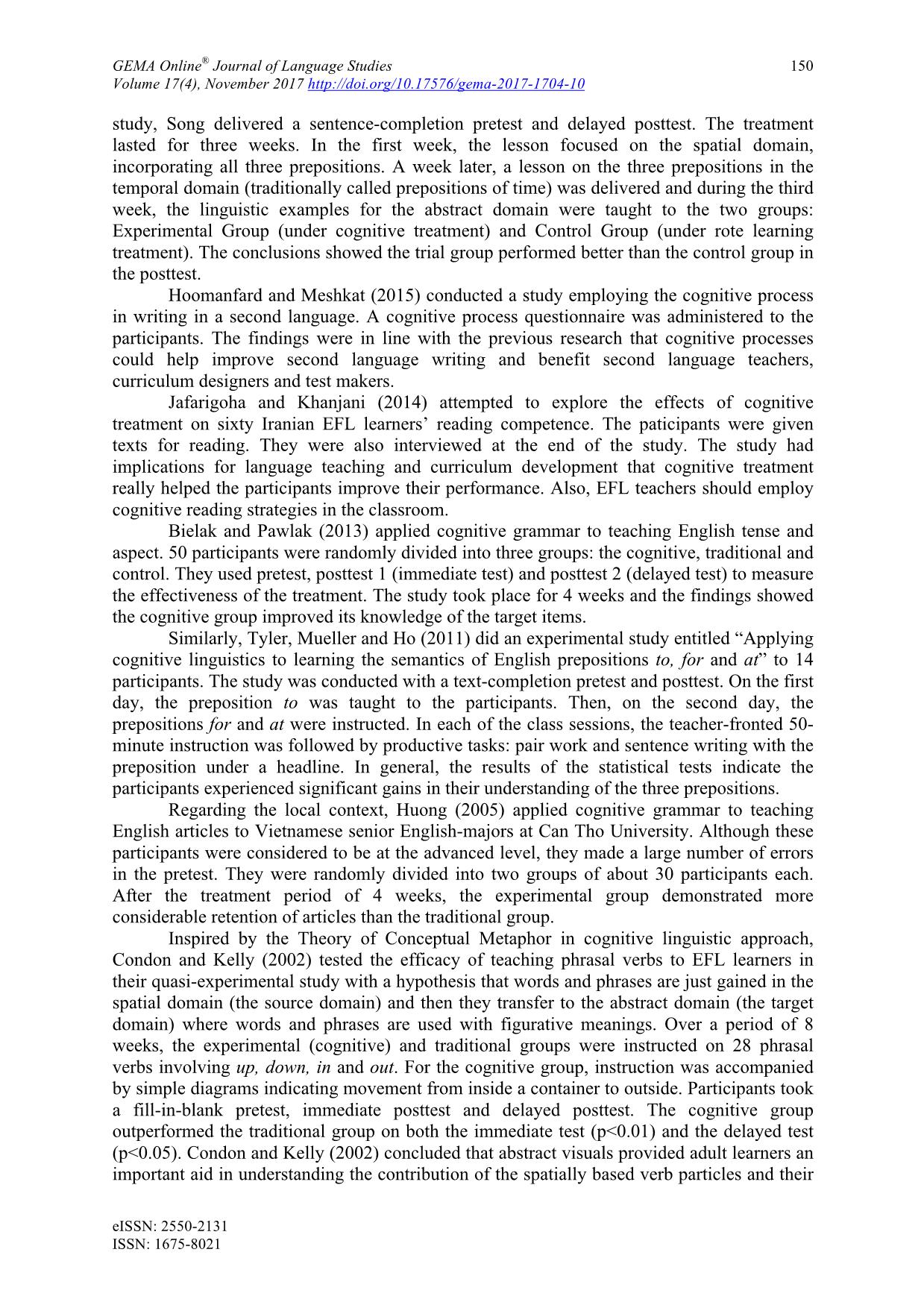
Trang 5
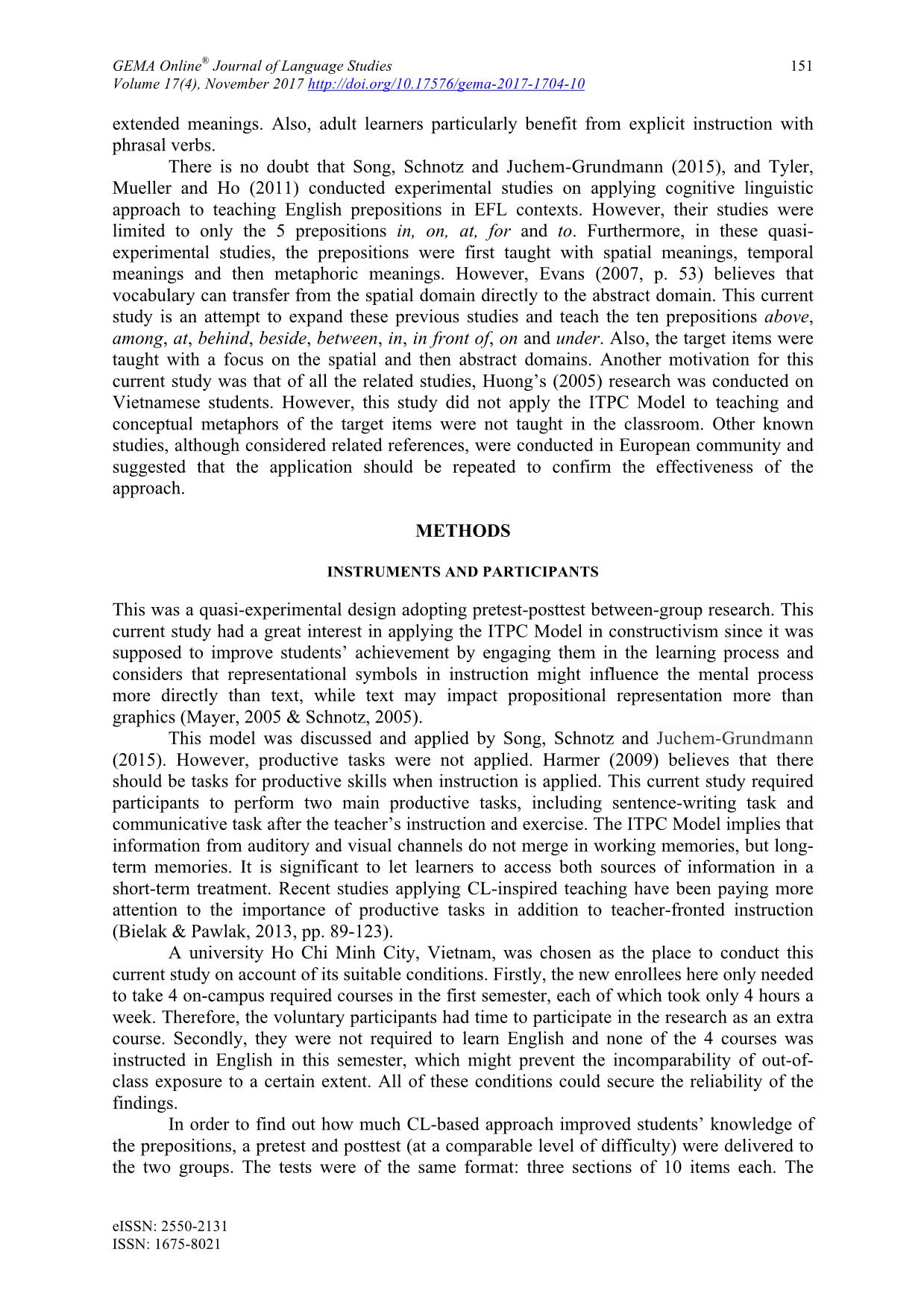
Trang 6
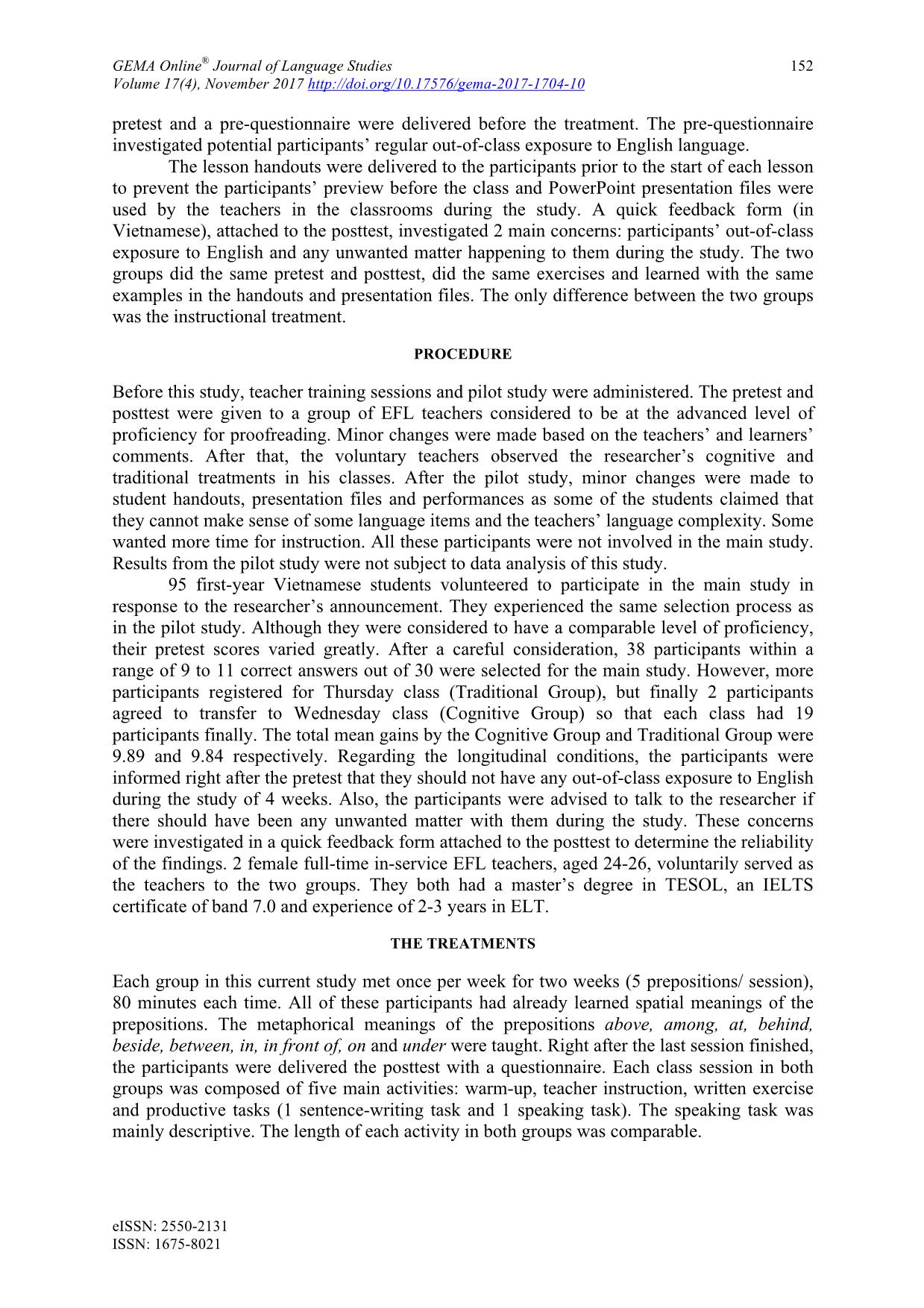
Trang 7
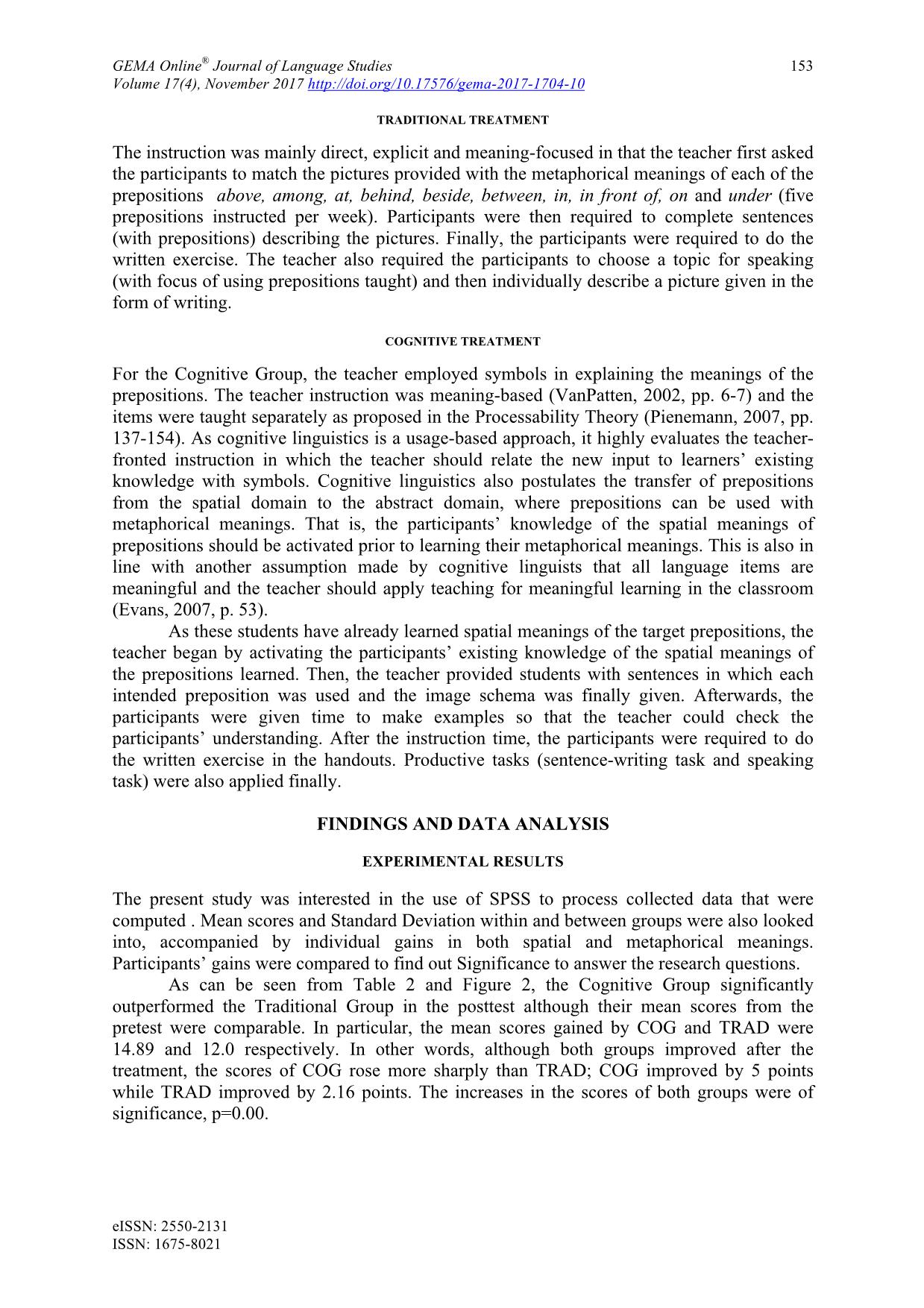
Trang 8
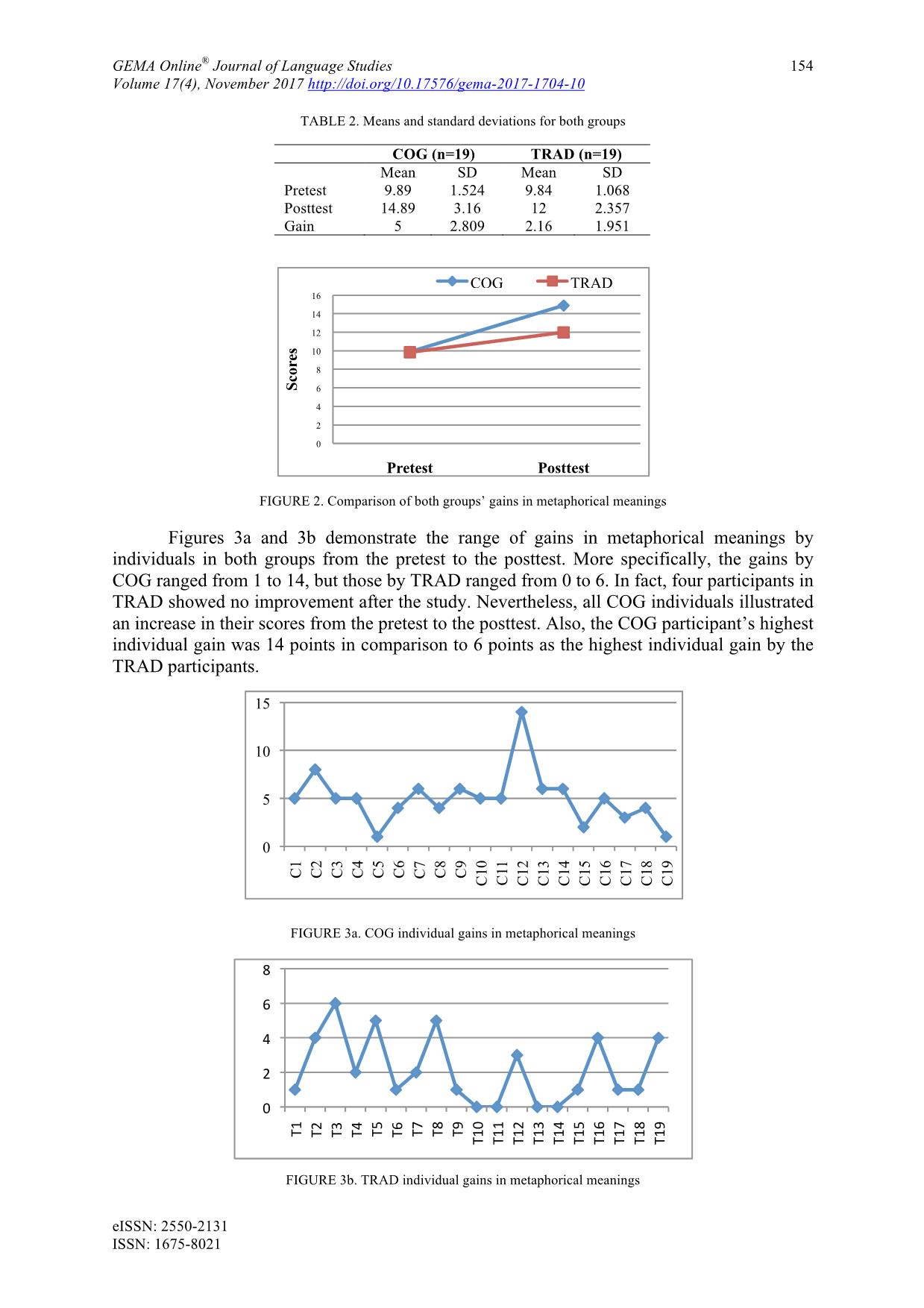
Trang 9
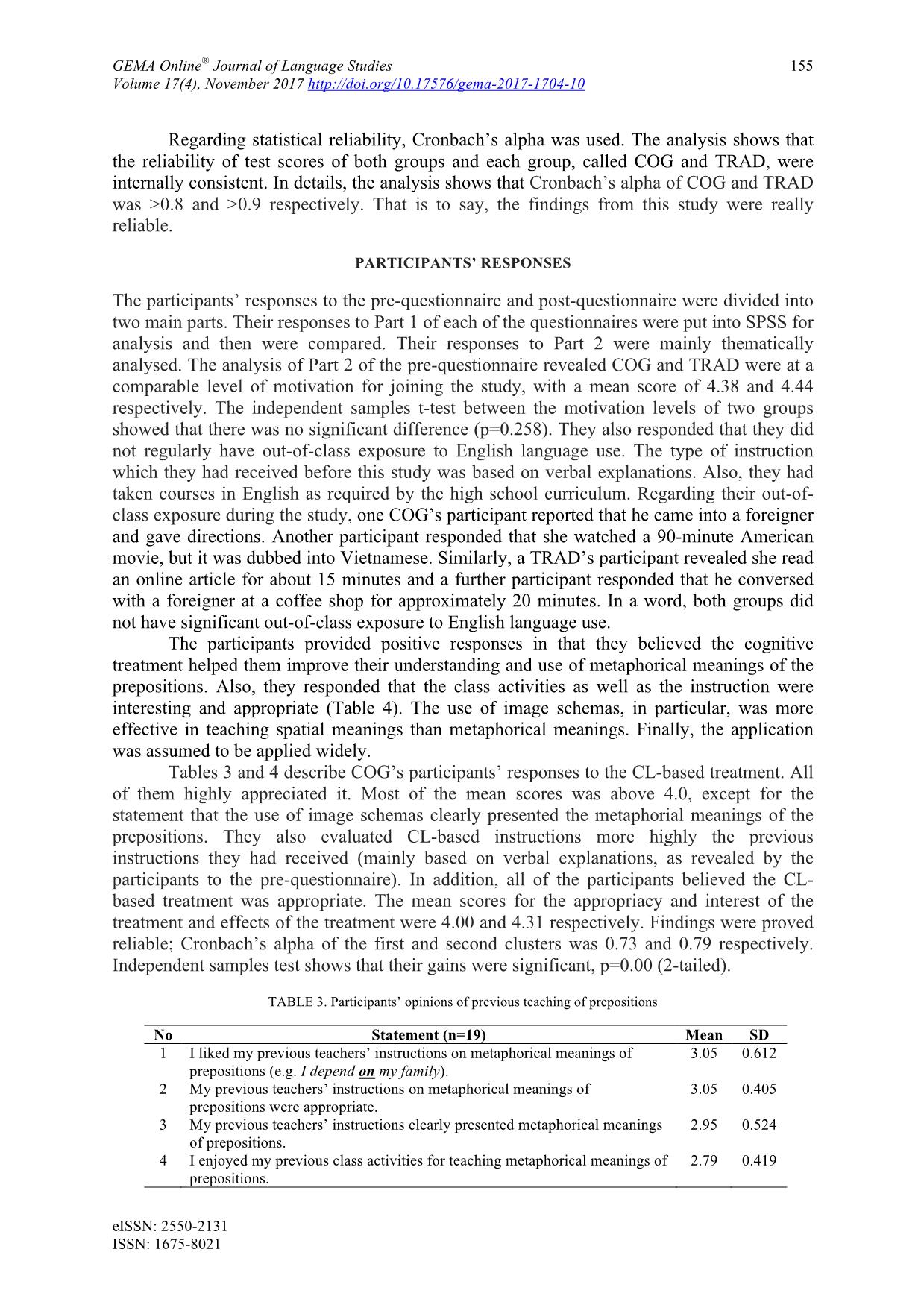
Trang 10
Tải về để xem bản đầy đủ
Tóm tắt nội dung tài liệu: Vietnamese Students Learning the Semantics of English Prepositions
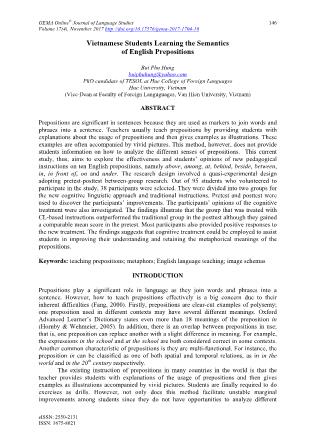
GEMA Online® Journal of Language Studies Volume 17(4), November 2017 eISSN: 2550-2131 ISSN: 1675-8021 146 Vietnamese Students Learning the Semantics of English Prepositions Bui Phu Hung buiphuhung@yahoo.com PhD candidate of TESOL at Hue College of Foreign Languages Hue University, Vietnam (Vice-Dean at Faculty of Foreign Languguages, Van Hien University, Vietnam) ABSTRACT Prepositions are significant in sentences because they are used as markers to join words and phrases into a sentence. Teachers usually teach prepositions by providing students with explanations about the usage of prepositions and then gives examples as illustrations. These examples are often accompanied by vivid pictures. This method, however, does not provide students information on how to analyze the different senses of prepositions. This current study, thus, aims to explore the effectiveness and students’ opinions of new pedagogical instructions on ten English prepositions, namely above, among, at, behind, beside, between, in, in front of, on and under. The research design involved a quasi-experimental design adopting pretest-posttest between-group research. Out of 95 students who volunteered to participate in the study, 38 participants were selected. They were divided into two groups for the new cognitive linguistic approach and traditional instructions. Pretest and posttest were used to discover the participants’ improvements. The participants’ opinions of the cognitive treatment were also investigated. The findings illustrate that the group that was treated with CL-based instructions outperformed the traditional group in the posttest although they gained a comparable mean score in the pretest. Most participants also provided positive responses to the new treatment. The findings suggests that cognitive treatment could be employed to assist students in improving their understanding and retaining the metaphorical meanings of the prepositions. Keywords: teaching prepositions; metaphors; English language teaching; image schemas INTRODUCTION Prepositions play a significant role in language as they join words and phrases into a sentence. However, how to teach prepositions effectively is a big concern due to their inherent difficulties (Fang, 2000). Firstly, prepositions are clear-cut examples of polysemy; one preposition used in different contexts may have several different meanings. Oxford Advanced Learner’s Dictionary states even more than 18 meanings of the preposition in (Hornby & Wehmeier, 2005). In addition, there is an overlap between prepositions in use; that is, one preposition can replace another with a slight difference in meaning. For example, the expressions in the school and at the school are both considered correct in some contexts. Another common characteristic of prepositions is they are multi-functional. For instance, the preposition in can be classified as one of both spatial and temporal relations, as in in the world and in the 20th century respectively. The existing instruction of prepositions in many countries in the world is that the teacher provides students with explanations of the usage of prepositions and then gives examples as illustrations accompanied by vivid pictures. Students are finally required to do exercises as drills. However, not only does this method facilitate unstable marginal improvements among students since they do not have opportunities to analyze different GEMA Online® Journal of Language Studies Volume 17(4), November 2017 eISSN: 2550-2131 ISSN: 1675-8021 147 senses of prepositions to profoundly comprehend them, but they also fail to gain knowledge by simple memorization and have no circumstances to synthesize their existing understanding with the target input (Cho, 2010, pp. 267-269 & Ausubel, 2000). Students, as a result, show low gains of prepositions since the isolated items in memory do not carve a long-term memory. Although English prepositions are considered complicated to learners, cognitive linguists assert that the meanings of prepositions can be represented in a form of symbols, which can be applied in teaching prepositions as they show the relations of things and/or people. A teaching method based on Cognitive Linguistic (CL) approach has been brought into consideration. CL considers language as symbolic as meaningful in virtues of both lexicon and grammar. The so-called symbolic theory derives from the symbolic nature of language, which can be employed to teach prepositions (Langacker, 1987, p. 12; Talmy, 1988). This study hopes to extend the previous relevant studies on applying the cognitive linguistic (CL) approach to teaching English prepositions. Song, Schnotz and Juchem- Grundmann (2015) did a quasi-experimental study on teaching the three prepositions in, on and at in Germany. Tyler, Mueller and Ho (2011) conducted a study on teaching the three prepositions to, for and at to 14 English learners who were Italian. Although, these studies were conducted in different countries, they were considered relevant references for this current study because they were all done on students who learned English as a foreign language and their findings proved positive. This current study intended to measure the impacts of CL-based teaching on learners’ understanding of the ten prepositions, namely above, among, at, behind, beside, between, in, in front of, on and under. The findings of the present research can provide an insight into the effective instruction of prepositions the teacher should present. In addition, curriculum designing and textbook writing will be benefited in terms of providing appropriate lessons and tasks to assist students in mastering English preposition. The accomplishment of the study will shed light on effective teaching of the aforementioned word class, and in turn help student ... vember 2017 eISSN: 2550-2131 ISSN: 1675-8021 155 Regarding statistical reliability, Cronbach’s alpha was used. The analysis shows that the reliability of test scores of both groups and each group, called COG and TRAD, were internally consistent. In details, the analysis shows that Cronbach’s alpha of COG and TRAD was >0.8 and >0.9 respectively. That is to say, the findings from this study were really reliable. PARTICIPANTS’ RESPONSES The participants’ responses to the pre-questionnaire and post-questionnaire were divided into two main parts. Their responses to Part 1 of each of the questionnaires were put into SPSS for analysis and then were compared. Their responses to Part 2 were mainly thematically analysed. The analysis of Part 2 of the pre-questionnaire revealed COG and TRAD were at a comparable level of motivation for joining the study, with a mean score of 4.38 and 4.44 respectively. The independent samples t-test between the motivation levels of two groups showed that there was no significant difference (p=0.258). They also responded that they did not regularly have out-of-class exposure to English language use. The type of instruction which they had received before this study was based on verbal explanations. Also, they had taken courses in English as required by the high school curriculum. Regarding their out-of- class exposure during the study, one COG’s participant reported that he came into a foreigner and gave directions. Another participant responded that she watched a 90-minute American movie, but it was dubbed into Vietnamese. Similarly, a TRAD’s participant revealed she read an online article for about 15 minutes and a further participant responded that he conversed with a foreigner at a coffee shop for approximately 20 minutes. In a word, both groups did not have significant out-of-class exposure to English language use. The participants provided positive responses in that they believed the cognitive treatment helped them improve their understanding and use of metaphorical meanings of the prepositions. Also, they responded that the class activities as well as the instruction were interesting and appropriate (Table 4). The use of image schemas, in particular, was more effective in teaching spatial meanings than metaphorical meanings. Finally, the application was assumed to be applied widely. Tables 3 and 4 describe COG’s participants’ responses to the CL-based treatment. All of them highly appreciated it. Most of the mean scores was above 4.0, except for the statement that the use of image schemas clearly presented the metaphorial meanings of the prepositions. They also evaluated CL-based instructions more highly the previous instructions they had received (mainly based on verbal explanations, as revealed by the participants to the pre-questionnaire). In addition, all of the participants believed the CL- based treatment was appropriate. The mean scores for the appropriacy and interest of the treatment and effects of the treatment were 4.00 and 4.31 respectively. Findings were proved reliable; Cronbach’s alpha of the first and second clusters was 0.73 and 0.79 respectively. Independent samples test shows that their gains were significant, p=0.00 (2-tailed). TABLE 3. Participants’ opinions of previous teaching of prepositions No Statement (n=19) Mean SD 1 I liked my previous teachers’ instructions on metaphorical meanings of prepositions (e.g. I depend on my family). 3.05 0.612 2 My previous teachers’ instructions on metaphorical meanings of prepositions were appropriate. 3.05 0.405 3 My previous teachers’ instructions clearly presented metaphorical meanings of prepositions. 2.95 0.524 4 I enjoyed my previous class activities for teaching metaphorical meanings of prepositions. 2.79 0.419 GEMA Online® Journal of Language Studies Volume 17(4), November 2017 eISSN: 2550-2131 ISSN: 1675-8021 156 5 My previous class activities for teaching metaphorical meanings of prepositions were appropriate. 3.16 0.501 TOTAL 3.00 0.291 6 My previous teachers helped me to easily understand metaphorical meanings of prepositions (e.g. I depend on my family.). 3.11 0.459 7 My previous teachers helped me retain metaphorical meanings of prepositions. 2.95 0.405 8 My previous teachers’ instructions on metaphorical meanings of prepositions were effective. 2.95 0.524 9 My previous teachers helped me to be able to effectively use metaphorical meanings of prepositions. 2.89 0.567 10 I would like to continue to learn metaphorical meanings of prepositions under my previous teachers’ instructions. 3.11 0.459 11 I believe that other teachers should apply my previous teachers’ instructions on metaphorical meanings of prepositions. 3.11 0.459 TOTAL 3.02 0.135 TABLE 4. Participants’ responses to the CL-based treatment in comparison with those to previous treatments No Statement (n=19) Post- questionnaire Gains Mean SD Mean SD 1 I liked the teachers’ instructions on metaphorical meanings of prepositions (e.g. I depend on my family). 4.53 0.697 1.47 0.814 2 The teachers’ instructions on metaphorical meanings of prepositions were appropriate. 4.79 0.419 1.74 0.562 3 The use of image schemas clearly presented metaphorical meanings of prepositions. 3.89 0.567 0.95 0.780 4 I enjoyed the class activities for teaching metaphorical meanings of prepositions. 4.16 0.501 1.37 0.684 5 The class activities for teaching metaphorical meanings of prepositions were appropriate. 4.63 0.496 1.47 0.772 TOTAL 4.00 0.371 1.40 0.503 6 The use of image schemas helped me to easily understand metaphorical meanings of prepositions (e.g. I depend on my family.). 4.32 0.671 1.21 0.787 7 The use of image schemas helped me retain metaphorical meanings of prepositions. 4.16 0.765 1.21 0.787 8 The teacher’s instructions on metaphorical meanings of prepositions were effective. 4.32 0.671 1.37 0.761 9 The teacher’s instructions helped me to be able to effectively use metaphorical meanings of prepositions. 4.11 0.658 1.21 0.713 10 I would like to continue to learn metaphorical meanings of prepositions under the teachers’ instructions. 4.42 0.607 1.32 0.885 11 I believe that other teachers should apply CL-based instructions on metaphorical meanings of prepositions. 4.53 0.513 1.42 0.692 TOTAL 4.31 0.456 1.29 0.487 CONCLUSION This current study was aimed to explore the effects of teaching based on CL, mostly on the participants’ understanding of the metaphorical meanings of the ten prepositions above, among, at, behind, beside, between, in, in front of, on and under. This study also compared the experimental results of the two instructional treatments, namely cognitive and traditional. The findings were in line with previous studies in EFL (Song, Schnotz & Juchem- Grundmann, 2015; Tyler, Mueller & Ho, 2011; Huong, 2005). Limitations of this kind of quasi-experimental study were inevitable. One weakness was about the selection of participants. More specifically, although extraneous variables that could have taken place during the study were investigated after the treatment, this was done GEMA Online® Journal of Language Studies Volume 17(4), November 2017 eISSN: 2550-2131 ISSN: 1675-8021 157 through the participants’ feedback. Also, the treatment was usage-based, followed by productive tasks; however, these follow-up activities were on a basis of sentence making. In other words, language accuracy rather than fluency was the focus. Whether or not the treatment could lead to fluency was not really explored even though productive tasks were involved. It is obvious from the study that cognitive treatment could help the participants improve their understanding and retain the metaphorical meanings of the prepositions. The application should be repeated several times to ensure its feasibility. Also, those who are interested in applying CL to ELT can conduct studies on other language items. EFL teachers can apply this treatment in their classrooms. The use of symbols and ITPC Model has proven to be more effective than the traditional pedagogical options. In a small scale, the teacher may be able to adapt the treatment according to the learners’ level of proficiency. Information achieved through both visual and auditory channels can help learners retain the input. EFL learners should also bear in mind that self-study is an issue of concern in that language learning strategies are crucial, which should be somewhat cognitive. Learners can also use symbols when learning and reviewing the lessons of prepositions. REFERENCE Ausubel, D. P. (2000). The Acquisition and Retention of Knowledge: A Cognitive View. Boston: Kluwer Academic Publishers. Bielak, J. & Pawlak, M. (2013). Applying Cognitive Grammar in the Foreign Language Classroom: Teaching English Tense and Aspect. Berlin: Springer. Cho, K. (2010). Fostering the acquisition of English prepositions by Japanese learners with networks and prototypes. In S. D. Knop, F. Boers, & A. D. Rycker (Eds.). Fostering Language Teaching Efficiency through Cognitive Linguistics (pp. 259-275). Berlin, Germany: Mouton de Gruyter. Condon, N. & Kelly, P. (2002). Does Cognitive Linguistics Have Anything to Offer English Language Learners in Their Efforts to Master Phrasal Verbs?. ITL Review of Applied Linguistics. Vol. 137/138, 205-231. Evans, V. (2007). A Glossary of Cognitive Linguistics. Utah: University of Utah Press. Evans, V. & Green, M. (2006). Cognitive Linguistics. An Introduction. Edinburgh: Edinburgh University Press. Fang, A. C. (2000). A Lexicalist Approach owards the Automatic Determination for the Syntactic Functions of Prepositional Phrases. Natural Language Engineering. Vol. 6(2), 183-200. Geeraerts, D. & Cuyckens, H. (2007). The Oxford Handbook of Cognitive Linguistics. Oxford: Oxford University Press. Harmer, J. (2009). The Practice of English Language Teaching. Essex, England: Pearson Education. Herskovits, N. (1986). Language and Spatial Cognition. Cambridge: Cambridge University Press. Hoomanfard, M. H. & Meshkat, M. (2015). Language and Spatial Cognitionwriting on a Computer and Using Paper and Pencil: Is There Any Difference in the Internal Cognitive Process? GEMA Online® Journal of Language Studies. Vol. 15(2), 17-31. Hornby, A. S. & Wehmeier, S. (2005). Oxford Advanced Learners’ Dictionary. Oxford: Oxford University Press. Huong, N. T. (2005). Vietnamese Students Mastering English Articles. Unpublished doctoral thesis, University of Groningen. GEMA Online® Journal of Language Studies Volume 17(4), November 2017 eISSN: 2550-2131 ISSN: 1675-8021 158 Jafarigohar, M. & Khanjani, A. (2014). Text Difficulty Effects on Metacognitive Reading Strategy use among EFL Learners. GEMA Online® Journal of Language Studies. Vol. 14(2), 47-59. Johnson, M. (1993). Moral Imagination. Chicago: University of Chicago Press. Lakoff, G. & Johnson, M. (1980). The Metaphorical Structure of the Human Conceptual System. Cognitive Science. Vol. 4, 195-208. Langacker, R. W. (1987). Foundations of Cognitive Grammar: Vol. 1. Theoretical Prerequisites. Stanford, California: Stanford University Press. Langacker, R. W. (1999). Assessing cognitive linguistic enterprise. In T. Janssen & G. Rederker (Eds.). Cognitive Linguistics: Foundations, Scope, and Methodology. Berlin: Mouton de Gruyter. Langacker, R. W. (2008). Cognitive grammar as a basis for language instruction. In P. Robinson & N. C. Ellis (Eds.). Handbook of Cognitive Linguistics and Second Language Acquisition (pp. 66-88). New York: Routledge. Lee, D. (2001). Cognitive Linguistics: An Introduction. New York: Oxford University Press. Mayer, R. (2005). The Cambridge Handbook of Multimedia Learning. Cambridge: Cambridge University Press. Pawlak, M. (2006). The Place of Form-focused Instruction in the Foreign Language Classroom. Kalisz: Wydzial Pedagogiczno-Artystyczny UAM. Pienemann M. (2007). Processability Theory. In VanPatten, B. & Williams, J., (Eds.). Theories in Second Language Acquisition: An Introduction . Mahwah, NJ: Lawrence Erlbaum. Radden, G. & Dirven, R. (2007). Cognitive English Grammar. Amsterdam: John Benjamins. Schnotz, W. (2005). An integrated model of text and picture comprehension. In R. E. Mayer (Ed.). Cambridge Handbook of Multimedia Learning (pp. 49-69). Cambridge: Cambridge University Press. Schnotz, W. & Banner, M. (2003). Construction and interference in learning from multiple representation. Learning and Instruction. Vol. 13(2), 141-156. Sohrabi, Z. & Pirnajmuddin, H. (2017). John Donne’s metaphors of self and empire: A cognitive analysis. 3L: Language Linguistics Literature®, Southeast Asian Journal of English Language Studies. Vol. 23(1). 14-26. Song, X., Schnotz W., & Juchem-Grundmann, C. (2015). A Cognitive Linguistic Approach to Teaching English Prepositions. In W. Schnotz, A. Kauertz, H. Ludwig, A. Muller & J. Pretsch. Multidisciplinary Research on Teaching and Learnin. (109-128). New York: Palgrave Macmillan. Talmy, L. (1988). Force Dynamics in Language and Cognition. Cognitive Science. Vol. 12, 49-100. Tyler, A., Mueller, C. & Ho, V. (2011). Applying Cognitive Linguistics to Learning the Semantics of English Prepositions to, for and at: An Experimental Investigation. Vigo International Journal of Applied Linguistics. Vol. 8, 181-205. VanPatten, B. (2002). Processing Instruction: An Update. Language Learning. Vol. 52, 755- 803. ABOUT THE AUTHOR Bui Phu Hung is a vice-dean at the Faculty of Foreign languages and Cultures-Van Hien University, Vietnam. He is currently a PhD candidate at Hue University.
File đính kèm:
 vietnamese_students_learning_the_semantics_of_english_prepos.pdf
vietnamese_students_learning_the_semantics_of_english_prepos.pdf

